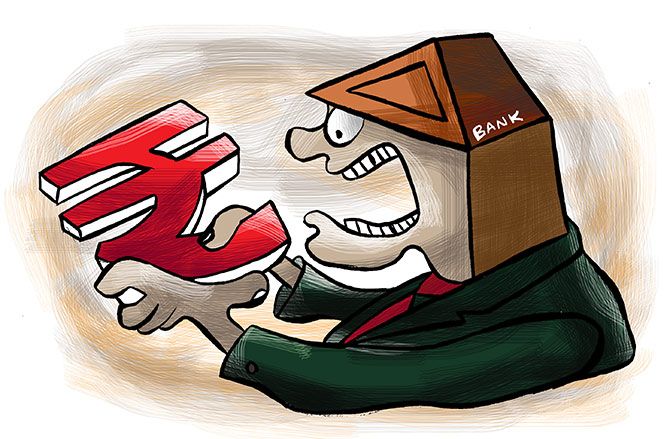Bad Bank. Good Intention. Bad Lending
Rogue lending under political influence was rife in the Congress-led regime and is not happening in the Modi regime, certainly not on that scale.
But if PSBs cannot lend as indiscriminately as they did last time in the name of ‘credit expansion’, how well will these banks do, asks Debashis Basu.
After 10 years of stagnation, the stock market is again excited about the prospects of public sector banks.
Of course, only the stock of State Bank of India has hit an all-time high, while most others are languishing far below their glory days of 2010-2011.
There are two reasons for this excitement: The launch of a ‘bad bank’ and the possible expansion of credit, as the economy picks up.
While it is true that both factors can theoretically make a big difference to the future of banks, it would help to learn some lessons from the past decade.
The previous time we saw the expansion of credit was not all innocent; it led to bad loans of Rs 20 trillion.
Is that the kind of outcome we want again?
The truth is that in the past 20 years, PSBs did well only during two massively unhealthy boom periods.
The first was 2003-2007, when real estate, metals, and a few manufacturing and capital goods companies saw a short period of scorching demand growth, which they needed to fund by borrowing large amounts of capital.
Unfortunately, promoters of very questionable intent and competence ran most of these businesses.
Unsurprisingly, these promoters found willing allies in PSB officials with no accountability.
All the PSBs were soon competing to dole out thousands of crores of rupees to large infrastructure projects in power, roads, steel, and realty.
As we know, big chunks of that lending turned bad. How bad was it?
Take a look at Lanco’s Babandh power project.
It is a template to explain what went wrong with several large, capital-guzzling projects in the past two decades.
The initial project cost was Rs 6,930 crore (Rs 69.30 billion), of which the promoters’ contribution was supposed to be 20 per cent with an 80 per cent debt component (cash credit, term loan, and a letter of credit/bank guarantee) to come from 14 Indian banks and Life Insurance Corporation.
CRISIL upgraded the credit rating of Lanco Infratech’s bank facilities to ‘A/stable/P2+’ in March 2010 from ‘BBB+/StableIP2’ in August 2008.
This represented an ‘improvement in Lanco Infratech’s overall business risk profile’.
Primarily, this was based on the expectation of a substantial increase in the operational asset base from 500 Mw in 2008 to 2,680 Mw by December 2010.
In March 2015, the project cost was revised to Rs 10,430 crore (Rs 104.30 billion) and further to Rs 11,949 crore (rs 119.49 billion) in June 2016.
Even in 2019, when Lanco came under a bankruptcy resolution, the project remained incomplete.
While Lanco’s admitted claim of project finance debt aggregated Rs 8,217 crore (Rs 82.17 billion), the average fair value and liquidation value stood at a paltry Rs 1,800 crore (Rs 18 billion) and Rs 900 crore (Rs 9 billion), respectively.
The sole bidder for this heap of junk was Vedanta Group, which offered cash of Rs 1 crore and 5 per cent equity — Rs 51 lakh (Rs 5.1 million) out of the paid-up capital of Rs 10.27 crore (Rs 102.7 million) after capital restructuring.
The bankers rejected the offer and Vedanta refused to improve upon it.
The project had gone into liquidation for a realisation of just Rs 290 crore (Rs 2.9 billion).
Contrast this with the fact that the government still refuses to accept Vijay Mallya’s offer to pay back in full!
A banker in the know says there were various issues in how banks dealt with project risk.
For instance: There was no pre-commitment condition requiring the company to mitigate project development risks; conditions precedent to the first disbursement were perfunctory and reflected the banks’ eagerness to release debt; the promoters’ operating results and financial position were not analysed to ascertain their ability to deliver; banks’ blind reliance on so-called ‘lenders’ independent engineer’ reflected a cavalier attitude of the banks.
In short, the banks’ accepted the promoter’s proposal without any serious appraisal.
The sanction memorandum was prepared in a perfunctory manner and there was no project monitoring.
The banker concludes: “Banks including LIC disbursed money without any risk mitigation.”
No surprise that more than Rs 3,000 crore (Rs 30 billion) was diverted from the project, including a Rs 1,000 crore (Rs 10 billion) excess advance paid to the EPC (engineering, procurement, construction) contractor.
The flagship, Lanco Infratech, is itself under liquidation along with seven power projects and one toll road project, mainly funded by PSBs.
If this was mere incompetence, we need to know how the same bankers would suddenly be more competent today.
If this was corruption, we need to know what will stop it this time, since the central government has not investigated any of these cases and has merely tinkered with PSBs by merging some of them.
Meanwhile, the government has announced a bad bank — National Asset Reconstruction Company Ltd (NARCL) — which will first purchase bad loans from banks.
This will leave PSBs to lend freely again, but whom will they lend to?
Rogue lending under political influence was rife in the Congress-led regime and is not happening in the Modi regime, certainly not on that scale.
There is no debt-fuelled false economic boom.
But if PSBs cannot lend as indiscriminately as they did last time in the name of “credit expansion”, how well will these banks do?
Debashis Basu is the editor of moneylife.in.
Feature Presentation: Aslam Hunani/Rediff.com
Source: Read Full Article

